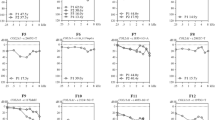Abstract
Turner syndrome (TS) is one of the most frequently encountered sex-linked chromosomal abnormalities, occurring in one per 2,000 female births. These patients present with short stature and failure to begin puberty. In this syndrome, there are multiple organ abnormalities, including auditory disorders. TS patients were referred to the ENT clinic by a pediatric endocrinologist. A questionnaire was filled out and the patients went through a complete otologic examination. They were then referred to the audiology clinic to undergo audiologic test battery plus high-frequency pure tone audiometry. From a total of 48 ears examined, 11 (22.9 %) had a normal audiometry. Mid-frequency sensorineural hearing loss (SNHL), high-frequency SNHL, combined and mixed hearing loss were diagnosed in 6 (12/5 %), 20 (41/7 %), 6 (12/5 %) and 1 (2/1 %) ear, respectively. Tympanogram results showed normal compliance (A, As, Ad) in the majority of cases. B and C patterns were found in a few cases. Speech discrimination score was normal in all patients whereas speech reception threshold was normal in 92 % of the ears. Audiometry abnormality especially SNHL is common in TS patients, with the high-frequency pattern being the most frequent.
Similar content being viewed by others
References
Gravholt Claus H (2009) Turner—know your body: an information book on Turner syndrome. Novo Nordisk, Malmo
Tuner HH (1939) A syndrome of infantilism, congenital webbed neck and cubitus valgus. Endocrinology 23:566–574
Crespi B (2008) Turner syndrome and the evolution of human sexual dimorphism. Evol Appl 1(3):449–461. doi:10.1111/j.1752-4571.2008.00017.x
Beckman A, Conway GS, Cadge B (2004) Audiological features of Turner’s syndrome in adults. Int J Audiol 43(9):533–544
Parkin M, Walker P (2009) Hearing loss in Turner syndrome. Int J Pediatr Otorhinolaryngol 73(2):243–247. doi:10.1016/j.ijporl.2008.10.012
Chan KC, Wang PC, Wu CM, Ho WL, Lo FS (2012) Otologic and audiologic features of ethnic Chinese patients with Turner syndrome in Taiwan. J Formos Med Assoc 111(2):94–100. doi:10.1016/j.jfma.2010.11.001
Anderson H, Filipsson R, Fluur E, Koch B, Lindsten J, Wedenberg E (1969) Hearing impairment in Turner’s syndrome. Acta Otolaryngol Suppl 247:1–26
Hederstierna C, Hultcranz M, Rosenhall U (2009) A longitudinal Study of hearing decline in women with tuner syndrome. Acta Otolaryngol 129(12):1434–1441. doi:10.3109/00016480902741962
Hultcranz M, Sylven L (1997) Turner’s syndrome and hearing disorders in women aged 16-34. Hear Res 103(1–2):69–74
Hultcranz M, Sylvan L, Borg E (1994) Ear and hearing problems in 44 middle-aged women with Turner’s syndrome. Hear Res 76(1–2):127–132
Dhooge IJ, De Vel E, Verhoye C, Lemmerling M, Vinck B (2005) Otologic disease in Turner syndrome. Otol neurotol 26(2):145–150
Verver EJ, Freriks K, Thomeer HG, Huygen DL, Pennings RJ et al (2011) Ear and hearing problems in relation to karyotype in children with Turner syndrome. Hear Res 275(1–2):81–88. doi:10.1016/j.heares.2010.12.007
Stenberg AE, Nylven O, Windh M, Hultcranz M (1998) Otological problems in children with Turner’s syndrome. Hear Res 124(1–2):85–90
Makisima T, King K, Brewer CC, Zalewski CK, Butman J, Bakalov VK et al (2009) Otolaryngologic markers for the early diagnosis of Turner syndrome. Int J Pediatr Otorhinolaryngol 73(11):1564–1567. doi:10.1016/j.ijporl
Watkin PM (1989) Otological disease in Turner syndrome. J Laryngol Otol 103(8):731–738
Han TS, Cadge B, Conway GS (2006) Hearing impairment and low bone mineral density increase the risk of bone fractures in women with Turner’s syndrome. Clin Endocrinol (Oxf) 65(5):643–647
Morimoto N, Tanaka T, Taiji H, Horikawa R, Naiki Y, Morimoto Y et al (2006) Hearing loss in Turner syndrome. J Pediatr 149(5):697–701
Acknowledgments
This study was supported by a grant from the Research Council of Mashhad University of Medical Sciences.
Conflict of interest
None to declare.
Author information
Authors and Affiliations
Corresponding author
Rights and permissions
About this article
Cite this article
Bakhshaee, M., Vakili, R., Nourizadeh, N. et al. Hearing disorders in Turner’s syndrome: a survey from Iran. Eur Arch Otorhinolaryngol 272, 3705–3708 (2015). https://doi.org/10.1007/s00405-014-3371-1
Received:
Accepted:
Published:
Issue Date:
DOI: https://doi.org/10.1007/s00405-014-3371-1




